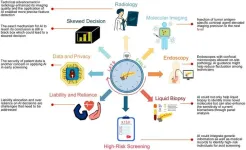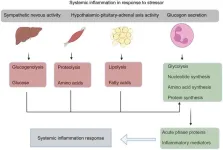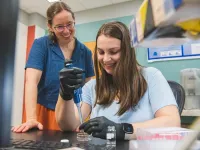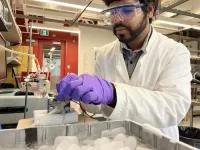(Press-News.org)
Pancreatic cancer (PC) presents substantial diagnostic challenges due to its aggressive nature and lack of early symptoms, leading to late detection and poor prognosis. According to recent cancer statistics, PC ranks as the fourth leading cause of cancer deaths globally, with increasing incidence, particularly in high-risk regions such as China. Factors such as a shortage of specific and reliable screening markers, along with a lower prevalence in the general population, make effective large-scale screening a formidable tasko assess advancements in diagnostic techniques, artificial intelligence integration, biomarker discoveries, and future prospects, highlighting the transformative potential of these approaches in detecting PC earlier and improving patient outcomes.
Advances in Diagnostic Technologies
Significant strides have been made in PC imaging techniques, notably high-resolution CT, MRI with diffusion-weighted imaging, and endoscopic ultrasonography (EUS). EUS, particularly with contrast enhancements, enables detailed visualization of pancreatic lesions, enhancing sensitivity in detecting small abnormalities. However, there are limitations, such as the need for highly trained operators and lengthy wait times, which hinder broader application. Emerging molecular imaging techniques, such as those using fibroblast activation protein (FAP) inhibitors for PET imaging, are promising in improving detection of even small lesions, potentially aiding in more precise staging and therapeutic planning.
Role of Arin Early Detection
AI is becoming instrumental in PC diagnostics, significantly improving the sensitivity and accuracy of early-stage lesion identification. AI models, trained on medical imaging and biomarker data, can analyze vast amounts of information to identify at-risk individuals and detect small pancreatic lesions. A noteworthy application is AI-driven radiomics, which extracts intricate patterns from medical images, potentially highlighting early signs of malignancy that human radiologists may miss . However, implementing AI in clinicaleful attention to bias mitigation, transparency, and data privacy issues, as well as developing models that perform consistently across diverse populations .
Advances in Biomarker Research and Liquid Biopsies
molecular biology have led to the identification of a range of blood-based biomarkers—such as circulating tumor cells (CTCs), cell-free DNA, and exosomes—that can serve as indicators of early-stage PC. Liquid biopsy, a non-invasive sampling technique, has shown potential in identifying these biomarkers, allowing for early diagnosis, monitoring treatment response, and evaluating prognosis. Novel biomarkers, including Piwi-interacting RNAs and various proteins, have demonstrated increased diagnostic specificity when used in conjunction with traditional markers like CA19-9 . The advent of combined biomarker panels, such as those incorporatilated DNA, has shown enhanced diagnostic accuracy, offering a promising avenue for more reliable PC screening.
Future Directions and Challenges
The future of PC diagnosis is likely to see a greater emphasis on low-cost, non-invasive screening methods powered by AI and molecular diagnostics. Future research must focus on identifying more cost-effective and widely applicable biomarkers and refining AI algorithms to reduce dependency on operator expertise and minimize healthcare disparities . As research advances, interdisciplinary collaboration among clinicians, researchers, any experts will be crucial to fully integrate these tools into routine practice. Such efforts hold promise for advancing early detection, personalizing treatment approaches, and ultimately improving survival rates among PC patients.
Conclusions
This review underscores the critical need for advancements in PC diagnostics to shift from late-stage detection to proactive early screening. By leveraging cutting-edge imaging technologies, novel biomarkers, and AI-driven analytics, early diagnosis of PC may become more achievable, significantly enhancing patient survival outcomes. Continuous innovation and collaboration across disciplines will be essential to overcome current limitations and establish more effective and accessible early diagnostic protocols.
Full text
https://www.xiahepublishing.com/2835-3315/CSP-2024-00006
The study was recently published in the Cancer Screening and Prevention.
Cancer Screening and Prevention (CSP) publishes high-quality research and review articles related to cancer screening and prevention. It aims to provide a platform for studies that develop innovative and creative strategies and precise models for screening, early detection, and prevention of various cancers. Studies on the integration of precision cancer prevention multiomics where cancer screening, early detection and prevention regimens can precisely reflect the risk of cancer from dissected genomic and environmental parameters are particularly welcome.
Follow us on X: @xiahepublishing
Follow us on LinkedIn: Xia & He Publishing Inc.
END
Acute-on-chronic liver failure (ACLF) is a life-threatening condition characterized by acute deterioration of liver function in patients with pre-existing chronic liver disease. It is often accompanied by multiorgan failure and systemic inflammation, with high short-term mortality rates. The triggers for ACLF include bacterial infections, acute alcoholic hepatitis, and ischemic hepatitis, leading to the release of pro-inflammatory mediators. These systemic inflammatory responses result in immune dysfunction, contributing to the progression of the disease.
Recent research has emphasized the metabolic changes ...
It may sound like a contradiction to talk about compassion in the competitive world of elite sport. After all, isn't elite sport all about becoming hardened to resistance and adversity?
But this is a false dichotomy, according to a new study that analysed the views of 12 Danish high-performance coaches on the use of compassion in their work with elite athletes.
In fact, there is a broad consensus among the coaches, most of whom are head of national teams, about the benefits of using compassion, says the study's lead author, Emilia Backman from the Department of Psychology, University of Copenhagen.
"All of the high-performance ...
UNIVERSITY PARK, Pa. — Scientists have spotted microplastics, tiny pieces of plastic smaller than 5 millimeters, in some of the most pristine environments on Earth, from the depths of the Mariana Trench to the snow on Mt. Everest to the mountaintop clouds of China and Japan. Microplastics have been detected in human brains, the bellies of sea turtles and the roots of plants. Now, new research led by Penn State scientists reveals that microplastics in the atmosphere could be affecting weather and climate.
The study, published today (Nov 7) in the journal Environmental Science and Technology: ...
Researchers with the ECOG-ACRIN Cancer Research Group (ECOG-ACRIN) and PrECOG, LLC, will present a variety of abstracts that aim to improve treatments for patients with lymphoma and acute leukemias at the 66th American Society of Hematology (ASH) Meeting & Exposition. The meeting is set to occur in San Diego, California, and virtually December 7 - 10, 2024.
Promising results from a phase 2 study (PrE0905) in patients with acute myeloid leukemia and new data from the practice-changing E1910 phase ...
Readily available thermoelectric generators operating under modest temperature differences can power CO2 conversion, according to a proof-of-concept study by chemists at the University of British Columbia (UBC).
The findings open up the intriguing possibility that the temperature differentials encountered in an array of environments—from a typical geothermal installation on Earth to the cold, desolate surface of Mars—could power the conversion of CO2 into a range of useful fuels and chemicals.
“The environment ...
Why is human culture — the shared body of knowledge passed down across generations — so much more powerful than animal cultures?
“What’s special about our species?” is a question scientists have wrestled with for centuries, and now a scientist at Arizona State University has a new hypothesis that could change the way we perceive ourselves, and the world around us.
“Ten years ago it was basically accepted that it was the ability of human culture to accumulate and evolve that made us special, but new discoveries about animal behavior are challenging these ideas and forcing us to rethink what makes our cultures, ...
Lumbar disc herniation is one of the most common structural changes in the lower back and the most common cause of radiating pain, or sciatica, in the leg.
Hereditary risk factors for disc herniations were investigated in a recently published international study led by a University of Oulu research group, utilising data from FinnGen, the Estonian Biobank, and the UK Biobank. The study analyzed the genetic and health data of 829,699 participants.
The study found 41 novel regions of the genome that modify the disease risk for disc herniations, in addition ...
New research into a chemical produced by a caterpillar fungus that has shown promise as a possible cancer treatment has revealed how it interacts with genes to interrupt cell growth signals. The discovery is an important step towards developing new drugs for the treatment of the disease.
The research into a chemical produced by a caterpillar fungus has revealed how it may work as a cancer treatment. It interrupts the cell growth signals that are overactive in cancer, an approach that could be less damaging to healthy ...
Philadelphia, November 7, 2024 – Melanoma accounts for only 1% of skin cancers in the United States but results in the largest number of skin cancer deaths. Investigators evaluated the potential link between the availability and use of tanning beds and the rising rates of melanoma in New England. They found compelling evidence linking tanning bed usage to increased melanoma risk. Their spatial epidemiologic study in the Journal of Investigative Dermatology, published by Elsevier, provides critical insights to inform public health strategies and reduce melanoma incidence.
The incidence of melanoma in the US has been increasing ...
Toronto, Canada, 7 November 2024 – From a curious young scientist investigating her grandfather's family wine to a leading expert in mitochondrial health and mental illness, Dr. Ana Cristina Andreazza's journey exemplifies the power of personal motivation in driving scientific innovation. As founder and Scientific Director of the Mitochondrial Innovation Initiative (Mito2i), Dr. Andreazza is revolutionizing our understanding of the connection between cellular energy production and mental health.
In an illuminating Genomic Press Interview, published in Brain Medicine on November 7, 2024, ...






